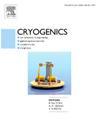Effect of regeneration temperatures on conversion efficiency of an ortho-to-parahydrogen catalyst
IF 2.1
3区 工程技术
Q3 PHYSICS, APPLIED
引用次数: 0
Abstract
At the European Spallation Source (ESS), two cold hydrogen moderator vessels were designed to enhance neutronic performance, particularly for generating high-brightness pulsed neutron beams used in neutron scattering experiments. This was achieved by optimizing the neutron scattering characteristics of parahydrogen, ensuring a fraction exceeding 99.5 %. Under intense neutron irradiation, para-to-orthohydrogen back conversion occurs due to energy transfer from neutron collisions. To meet the hydrogen moderator requirements, hydrous ferric oxide, commercially known as IONEX® Type OP, was selected as the ortho-to-parahydrogen catalyst. In this study, water was first identified as the primary adsorbate on the catalyst through qualitative analysis. A subsequent quantitative assessment of the adsorbed water content revealed that at each activation temperature (TR), there was a distinct limit to the amount of water that could be removed. Heating the catalyst to 250 °C enabled the removal of the vast majority of the adsorbed water. To investigate the influence of the residual water on the catalyst conversion performance, the ortho-to-parahydrogen fractions of hydrogen passing through the activated catalyst immersed in saturated liquid nitrogen were measured using Raman spectroscopy. The catalyst’s conversion performance improved as TR increased to 160 °C, attributed to the removal of water. However, at a higher TR of 230 °C, catalyst performance deteriorated to a level comparable to that observed at TR = 130 °C. Once catalyst degradation occurred due to overheating, performance could not be recovered. When the residual water content (WR) after activation exceeded 1.4 wt%, corresponding to TR = 160 °C, a linear relationship was identified between WR and both the efficiency degradation and the rate constant, with both improving as WR decreased. These findings suggested the catalyst conversion performances could be indirectly inferred from WR, thereby eliminating the need for cryogenic temperature measurements.
再生温度对正氢-对氢催化剂转化效率的影响
在欧洲散裂源(ESS),设计了两个冷氢慢化剂容器来提高中子性能,特别是用于产生用于中子散射实验的高亮度脉冲中子束。这是通过优化对氢的中子散射特性来实现的,确保了分数超过99.5%。在强中子辐照下,由于中子碰撞的能量转移,对位氢向正位氢的反转化发生。为了满足氢慢化剂的要求,选择了氢氧化铁,商业上称为IONEX®Type OP,作为正位到对氢催化剂。在本研究中,首先通过定性分析确定了水是催化剂上的主要吸附物。随后对吸附水含量的定量评估表明,在每个活化温度(TR)下,可以去除的水量都有明显的限制。将催化剂加热到250°C,可以去除绝大多数吸附的水。为了研究残余水对催化剂转化性能的影响,采用拉曼光谱法测定了浸没在饱和液氮中的活化催化剂中氢气的正氢到对氢组分。当温度升高到160℃时,催化剂的转化性能有所提高,这主要是由于水的去除。然而,在更高的TR为230°C时,催化剂的性能下降到与TR = 130°C时相当的水平。一旦催化剂因过热而发生降解,性能就无法恢复。当活化后的剩余水含量(WR)超过1.4 wt% (TR = 160℃)时,WR与效率降解和速率常数均呈线性关系,且随WR的降低而提高。这些发现表明,可以从WR间接推断催化剂的转化性能,从而消除了对低温测量的需要。
本文章由计算机程序翻译,如有差异,请以英文原文为准。
求助全文
约1分钟内获得全文
求助全文
来源期刊

Cryogenics
物理-热力学
CiteScore
3.80
自引率
9.50%
发文量
0
审稿时长
2.1 months
期刊介绍:
Cryogenics is the world''s leading journal focusing on all aspects of cryoengineering and cryogenics. Papers published in Cryogenics cover a wide variety of subjects in low temperature engineering and research. Among the areas covered are:
- Applications of superconductivity: magnets, electronics, devices
- Superconductors and their properties
- Properties of materials: metals, alloys, composites, polymers, insulations
- New applications of cryogenic technology to processes, devices, machinery
- Refrigeration and liquefaction technology
- Thermodynamics
- Fluid properties and fluid mechanics
- Heat transfer
- Thermometry and measurement science
- Cryogenics in medicine
- Cryoelectronics
 求助内容:
求助内容: 应助结果提醒方式:
应助结果提醒方式:


